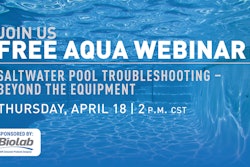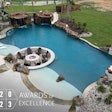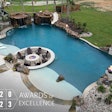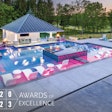
|
Learn more about hot tub water care at Chris Marcano’s seminar at the upcoming PSP Expo in Las Vegas. Called “Treating Spas Like Pools Could Get You in Hot Water: A Custom Approach to Hot Water Care,” the course will take place Wednesday, Oct. 31, from 11:45 a.m. to 12:30 p.m.. |
If there’s one thing I wish I could tell everyone about hot tubs, it’s this: A hot tub is not a “mini swimming pool.” It’s a completely different body of water that abides by a different set of standards for water treatment.
You’d think that would be obvious, but in my time in the pool and spa industry, I’ve learned that fundamental misunderstanding — that you cannot approach pool and hot tub water chemistry the same way — is more often than not the catalyst for issues like cloudiness, foaming, sliminess and more.
Here, I’ll provide a broad primer about what sets hot tubs apart from their swimming pool counterparts.
BROAD STROKES
Let’s start with some of the basics. There are many differences between a pool and hot tub (some more obvious and others), including:
• Temperature: The temperature in pools will often range from 79-84 degrees Fahrenheit (26-29 degrees Celsius), while spas and hot tubs typically run from 98-104 degrees Fahrenheit (37-40 degrees Celsius).
• Evaporation rate: Hot tubs have a higher evaporation rate, which can lead to more scale and higher calcium levels, with air jets and blowers causing a quicker chemical reduction.
• Water balance: A smaller body of water means a greater effect on pH, total alkalinity, calcium hardness and TDS from added chemicals.
• Bather load ratio: Three people in a backyard hot tub is equivalent to about 250 people in a backyard swimming pool.
WHAT LIES BENEATH
Let’s discuss how some of the above characteristics impact water chemistry. Whenever a person gets into a hot tub, they’re introducing bodily waste, pathogens, germs and bacteria into the spa water. Non-living waste, like sweat, dirt, sunscreen, perfumes, lotions, etc., is largely harmless. But because hot tubs only contain a small volume of water, such waste creates an incredibly high demand on the sanitizer. (That’s the bather load-ratio at work.)
In addition, a surprising number of people carry disease-causing pathogens, germs and bacteria on the surface of their bodies. Examples of bacteria carried on the skin include Staphylococcus aureus, methicillin-resistant Staphylococcus aureus and pseudomonas. People can also shed gastrointestinal pathogens from their feces, such as E. coli, shigella, vibrio, norovirus and cryptosporidium. (The list of germs that love to hang out in hot tubs is unfortunately and horrendously long.)
Related: When It Comes To Water Care, Don't Think Of A Spa As Just A Small Pool
You can transmit bacterial infections and viruses in large pools, even though the pathogens and fecal matter have more space to roam around. However, the same amount of germs in a hot tub, a much more concentrated setting, creates a higher risk of infection. (According to the Centers for Disease Control and Prevention, when the water’s pH is kept within the proper range and the tub is disinfected as recommended, infection risk is low.)
Also complicating things is temperature. While hot tub water is, well, hot, it is nowhere near hot enough to kill bacteria and other germs. In actuality, the warm, wet environment of a hot tub supports bacterial growth and survival. Germs are perfectly happy living at typical hot tub temperatures and can survive for days, even weeks.
WATER BALANCE
As mentioned previously, the smaller body of water found in a hot tub can have a greater effect on water balance. These are the two most important levels to keep in mind:
Total Alkalinity: This creates a buffer in the water so that it can resist any acids that may be added to the water. This is the first and most important adjustment to be made. Total alkalinity acts as a control to the pH. The pH cannot be properly adjusted if the total alkalinity is out of the suggested ranges. The recommended total alkalinity range in spas and hot tubs is 80-120 ppm.
pH: This is a measurement of the acids or bases in the water. A low pH indicates the water is primarily acidic. A high pH means the water is more basic or alkaline. A good tool for adjusting and maintaining pH and alkalinity at the correct level between draining is to use a product that holds the pH steady by boosting the total alkalinity. The technology here raises up the alkalinity by adding a soft form of calcium to the water. The result is that the pH gets locked in and can’t be easily affected by acids. This is an ideal product for use in areas with low minerals and softer water, but is not recommended for areas with harder water.
SANITIZING
Like swimming pools, hot tubs can be sanitized via several methods, with chlorine and bromine being the most popular.
Chlorine: Should be maintained at 3 ppm. The best type of chlorine for hot tubs is sodium dichlor. This granular material is available in two different strengths: 56 percent and 62 percent. The pH of both types of dichlor is near neutral at 6, so it has much less capability of destroying total alkalinity and pulling down the pH.
Bromine: Should be between 4-6 ppm. Bromine can be more practical choice than chlorine for a couple of reasons: first, bromine holds longer in hot water than chlorine, and second, a bromine feeder can be used to ensure there is proper sanitization on a daily basis. Bromine generators that use sodium bromide and electrolysis to create sanitizer are another viable option.
UV and Ozone: These units can be very practical in caring for the water because they work daily to oxidize and purify water. They are especially effective when used in tandem with a weekly chemical treatment.
Regular Shocking: Hot tubs should be shocked with a chlorine-free shock or sodium dichlor granular chlorine at each service.
One of the most important parts of maintaining a hot tub is adding enough sanitizer before finishing up. If you don’t, the water will spend hours and hours just sitting still at a high temperature, allowing the chlorine or bromine to continue breaking down and enabling more bacteria to grow. Since no one is adding sanitizer every few hours throughout the night, it’s important to try to “shock” the water with a higher amount before the hot tub is shut down.
RELATED: How to Lengthen the Life of Hot Tub Water
Public hot tub are subject to rules and regulations about chlorine levels. There are also lifeguards or other staff who routinely check the chlorine levels and adjust accordingly. Private hot tubs, however, are a different story. It is up to the owner to be diligent about cleaning, and people get lazy when it’s only family and friends using the tub. It doesn’t matter whether it’s your spouse in the hot tub with you or a complete stranger, the bottom line is that everyone who enters a hot tub is polluting it. Whether it’s cloudy water, odors, unbalanced water or sanitizer demand, the main culprit is waste from bathers.
Clarifiers: Unfortunately, many people suffer the misconception that clarifiers should only be used when water turns cloudy. While clarifiers will work to clear cloudy water, the real purpose of a clarifier is to help prevent water from becoming cloudy in the first place. This is especially pertinent to hot tubs due to the precise water chemistry requirements. Therefore, a clarifier should be used weekly as part of the regular maintenance routine. Also take into consideration the type of clarifier being used. Make sure you select a naturally based nonpetroleum clarifier to avoid adding oil to the water.
Also, adding a blend of broad-spectrum enzymes will control the nonliving organic waste and other bather contaminants in a hot tub. It is easy to use and effective. The water will not only be clearer, but it will be easier to manage and maintain in the long term.
As I mentioned at the beginning of this piece, it’s very important for us as pool professionals to remember that pool and hot tub water are not the same. And if you treat them the same way, it’ll be you in hot water.
Chris Marcano is National Director of Training and Education at NC Brands, Overland Park, Kan.







































